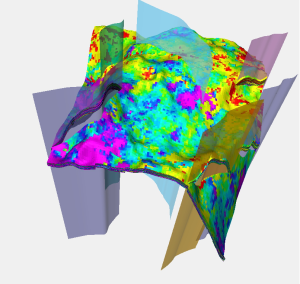3D modeling
Ufa Scientific and Technical Center performs a range of services for creating and history-matching of static and dynamic reservoir models
STATIC RESERVOIR MODELS
Tasks
- Oil and gas reserves calculations
- Planning drilling campaigns (well design and placement)
- Risk analysis and uncertainty quantification
- Creating framework for fluid flow simulations
Main workflow stages

- Gathering, analysis and preparation of the required data, uploading
- Structure modeling (reservoir framework)
- Creating a grid (3D grid), averaging well data for the grid
(assigning properties to grid cells) - Facies (lithology) modeling
- Rock physics modeling
- Hydrocarbon reserves calculations
DYNAMIC MODELING
Dynamic or fluid flow models are an integral part of field development project documentation which a license holder or operator company is required to submit to the designated approving authorities. These models are also used to monitor field depletion processes
Tasks

- Plan production levels and optimize reservoir depletion rates
- Detailed study of in-situ fluid flow dynamics
- Study of well behavior and reservoir performance
- Evaluation of field development investment risks
- Gathering, analysis and input control of initial data
- Selecting model types
- Creating a reservoir model
- History-matching including the results of completed geological and technical operations (workover, IOR/EOR, remedial cementing etc.)
- Analysis of the current reservoir energy state for the modeled area based on current reservoir pressure maps created from the dynamic fluid flow model
- Localization and feasibility studies for remaining recoverable reserves within the planned drilling location
- Forecasting and analysis of results
Reservoir simulations are a cost efficient tool for increasing the success rate of new wells including the following:
- On-the-spot analysis of depletion state for the target reservoir
- Identification of remaining reserves, by-passed oil and high-yield sweet spots not drained by nearby wells with the existing depletion pattern
- Selection of best well placement strategy and optimum well trajectory based on historic production from offset wells and current areal and vertical sweep
- Selection of best net pay intervals for completion
- Forecasting well production

 +7 347 2460582
+7 347 2460582